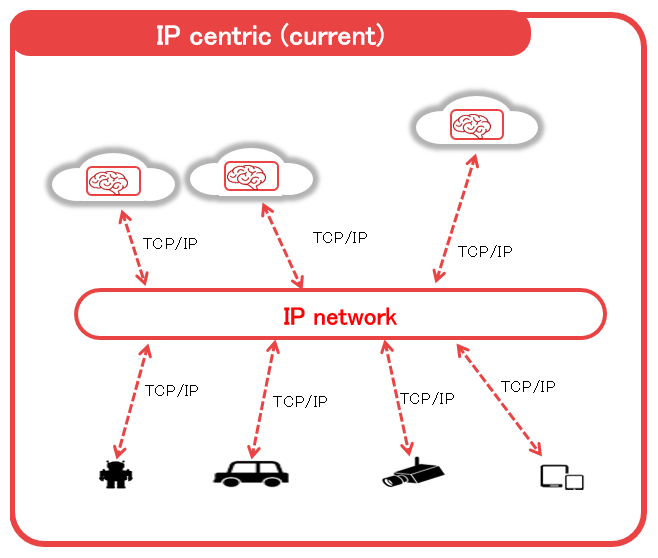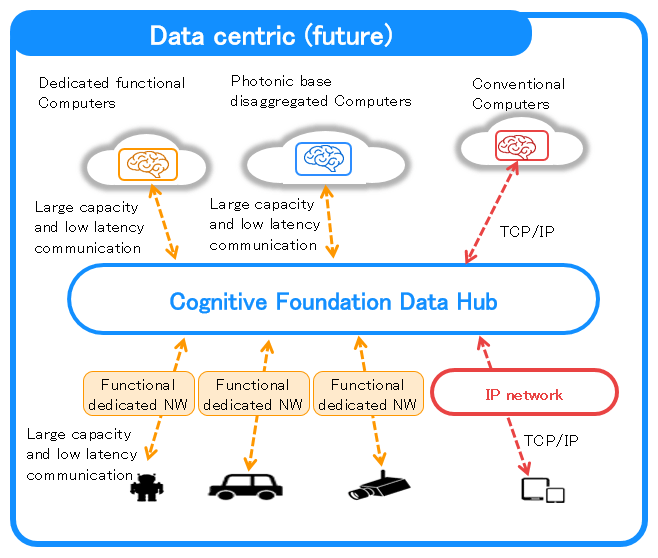Microsoft ends support for Internet Explorer on June 16, 2022.
We recommend using one of the browsers listed below.
- Microsoft Edge(Latest version)
- Mozilla Firefox(Latest version)
- Google Chrome(Latest version)
- Apple Safari(Latest version)
Please contact your browser provider for download and installation instructions.
April 16, 2020
NTT Corporation
Technology development roadmap for realizing the IOWN concept
NTT Corporation (Head Office: Chiyoda-ku, Tokyo; President and CEO: Jun Sawada; hereinafter "NTT") has defined a technology roadmap for Innovative Optical and Wireless Network (IOWN). Starting in 2021, NTT will release reference models for IOWN's key technologies and conduct field trials with partner companies to prove IOWN's immense potential as an accelerator for Smart World.
1. NTT's Initiatives and Development Roadmap
Reflecting on the four technical directions in the IOWN GF whitepaper*1, NTT will work on the following technology developments. Figure 1 shows the technology development roadmap. The Years in blankets are target years when the reference models will be developed.
(1) Full-Stack Communication Acceleration (Layer 4/Layer 3 Acceleration*2: CY2021, Technology for massive optical/wireless capacity: CY2023)
In order to take full advantage of the large capacity of IOWN All-Photonics Network, we will develop a new accelerated Layer 4/Layer 3 communication method that is less subject to the distance-related throughput degradation than TCP/IP. As the new communication method will lead to the explosive growth of data traffic, we will also develop a new network architecture and technology for massive optical and wireless capacity.
*2The transport (Layer4) and network (Layer3) layers of the ISO (International Organization for Standardization "International Organization for Standardization") OSI Reference Model
(2) Data-Centric Communication and Computing (CY2021)
As an essential component of the Cognitive Foundation®, we will develop Cognitive Foundation Data Hub (CF Data Hub), which enables nodes (sensor nodes or AI analysis nodes) to instantly exchange or share large data objects. By leveraging CF Data Hub as a central exchange point that faces multiple types of networks and computing infrastructures, IT infrastructures will shift from the conventional IP-centric paradigm to a new data-centric paradigm. For details, please refer to 2 (1).
(3) Computing Scaling Across Device, Edge, and Center Cloud (CY2021)
We will develop a high-speed distributed computing technology that leverages ultra-broadband and low-latency communication on IOWN All-Photonics Network to realize a new cloud computing infrastructure that seamlessly spans multiple data centers.
(4) Sustainable Growth with Energy Efficiency (CY2023)
We will develop an architecture and technologies for photonic disaggregated computing, which significantly improves energy efficiency by replacing electronic data bus for inter-module data transfer with photonic data plane. After that, shift from electronic to photonic will also be applied to inter-package and inter-device interconnections on a step by step basis, which will eventually lead to a quantum leap improvement in energy efficiency. For details, please refer to 2 (2).
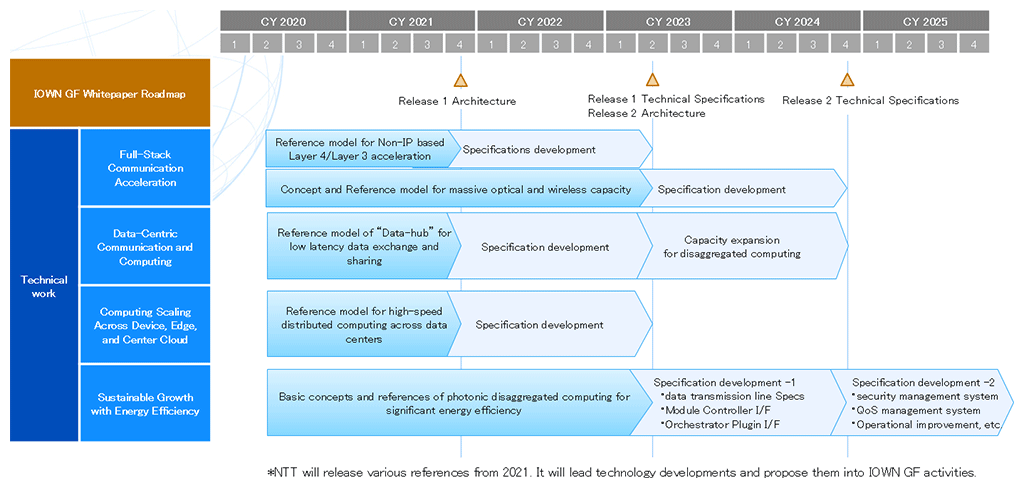 Figure 1: IOWN Technology Development Roadmap
Figure 1: IOWN Technology Development Roadmap
2. Technology Overview
(1) CF Data Hub and Data-Centric Communication and Computing
CF Data Hub is an infrastructure that consists of multiple servers distributed over a wide area. With its data brokerage functions and shared data storage, it enables nodes, e.g. sensor nodes and AI analysis nodes, to instantly exchange or share large data objects. By accessing the nearest server, a node can post data to CF Data Hub at a high transfer rate. As the data brokerage function and shared data storage can also accommodate data exchange with multiple data consumers or publishers, CF Data Hub can reduce traffic on underlying network infrastructure and thus improves infrastructure's efficiency.
CF Data Hub provides multiple interfaces for multiple types of networks including IP-based and non-IP-based. In particular, a node connected with IOWN All-Photonics Network can leverage an accelerated Layer 4/Layer 3 communication method to instantly transfer large data objects. In this way, CF Data Hub will be a central data exchange point for multiple types of networks and computing infrastructures. This will lead to a paradigm shift in IT infrastructure from today's IP-Centric paradigm to a new Data-Centric paradigm.
Figure 2 CF Data Hub and Data-Centric Architecture
(2) Photonic Disaggregated Computing
Photonic Disaggregated Computing is a new computing architecture that leverages photonic data planes and enables us to shift from the traditional box-oriented paradigm to a new boxless paradigm.
By enabling each module, such as memory and AI computing device, with photonic I/O (Input/Output) and connecting modules with a high-capacity and high-speed photonic data plane, photonic disaggregated computing achieves a high computing capacity and flexibility. NTT's optoelectronic integration technology will also enable photonics-based inter-package and inter-chip data transfer, which will eventually lead to quantum leap improvement in computing efficiency.
-
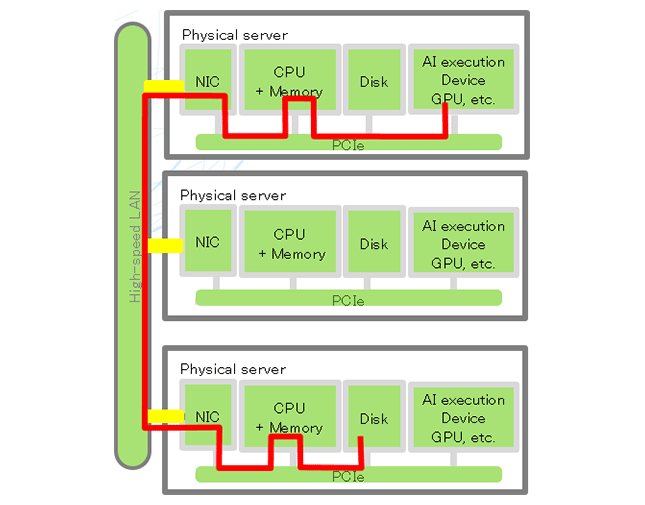 (a) Current (Physical Server Oriented)
(a) Current (Physical Server Oriented)
-
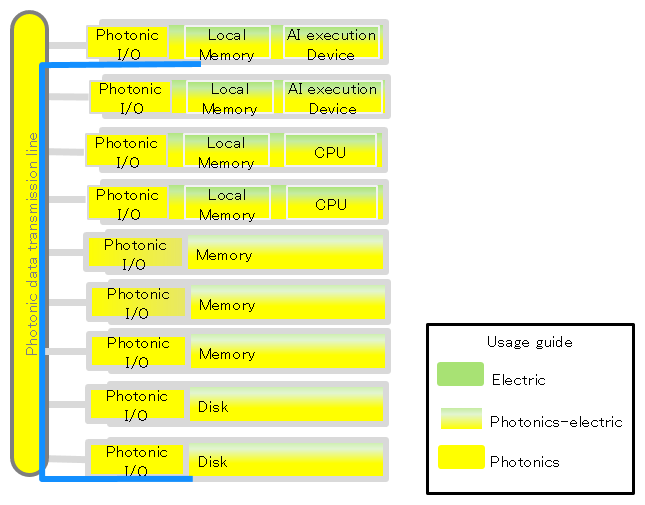 (b) Disaggregated computing
(b) Disaggregated computing
Figure 3 Disaggregated Computing
3. Expected Impacts
The developed technologies including Data-Centric Communication and Computing and Photonic Disaggregated Computing will accelerate the creation of a natural cyberspace with many Smart World applications.
For example, the data hub that can accommodate large data objects with strict latency requirements will enable AI-based autonomous control systems with beyond-human cognitive capacity and beyond-human response speed. Besides, very high computing efficiency will enable the orchestra of many AI functions for society-scale overall optimization and a large-scale simulation for predicting future.
In addition, as CF Data Hub facilitates interactions among multiple AI functions flexibly on an on-demand basis, it will enable the mashup development of AI services, creating a new AI service that invokes existing AI functions on the network. This will lead to the accumulation of Smart World's social capital on top of IOWN as a platform.
Last but not least, the technologies will contribute to the realization of a sustainable society with highly efficient computing infrastructure and ultra-low power consumption.
4. Future Initiatives
In accordance with this technology development roadmap, we will start releasing reference models for the above-mentioned technologies in 2021. NTT will also propose the reference models to IOWN GF for further specification development. At the same time, NTT will conduct field trials with industry-leading partners to prove the benefits of the developed technologies.
Media contacts
NTT Corporation
Press Relations
ntt-cnr-ml@hco.ntt.co.jp
Information is current as of the date of issue of the individual press release.
Please be advised that information may be outdated after that point.
NTT STORY
WEB media that thinks about the future with NTT



